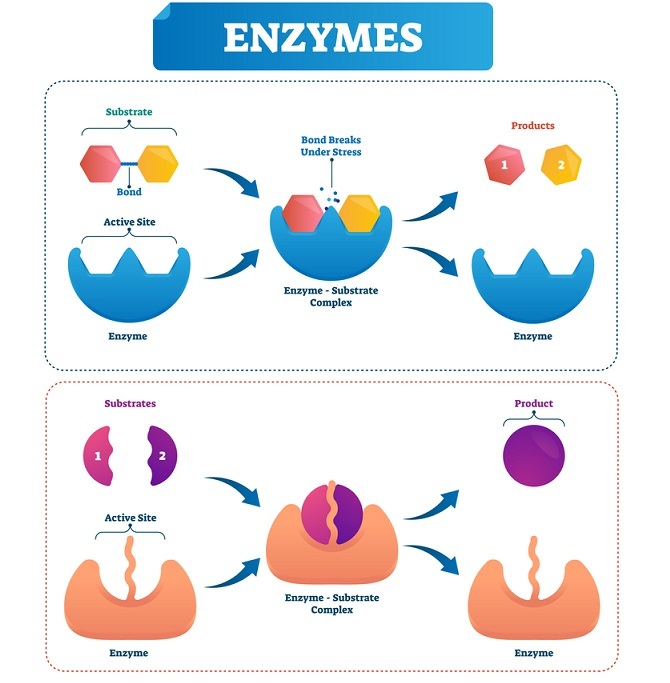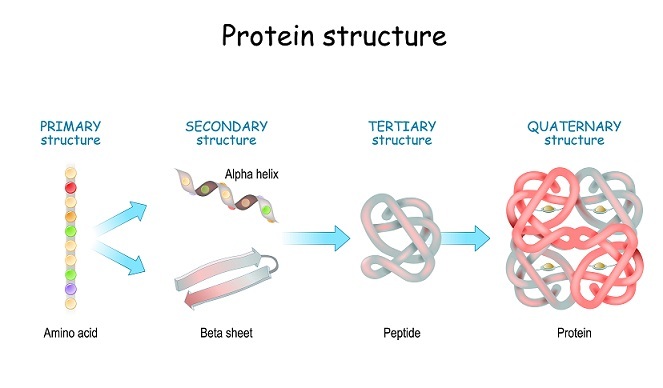
 Data Structure
Data Structure Networking
Networking RDBMS
RDBMS Operating System
Operating System Java
Java MS Excel
MS Excel iOS
iOS HTML
HTML CSS
CSS Android
Android Python
Python C Programming
C Programming C++
C++ C#
C# MongoDB
MongoDB MySQL
MySQL Javascript
Javascript PHP
PHP
- Selected Reading
- UPSC IAS Exams Notes
- Developer's Best Practices
- Questions and Answers
- Effective Resume Writing
- HR Interview Questions
- Computer Glossary
- Who is Who
Enzyme Technology: Applications and Commercial Significance
What are Enzymes?
Enzymes are the substances which acts as catalyst in regulating various chemical  reactions in living organisms. The presence of these enzymes speeds up the reaction by being itself unaltered.
reactions in living organisms. The presence of these enzymes speeds up the reaction by being itself unaltered.
Enzymes which are also called as biocatalysts are the protein molecules made up of long chain of amino acids. These long chains are usually folded to form an active site in an enzyme. The substrate which then binds to this site forming a complex. Once the reaction is done the products are released making the enzyme available for other reactions.
The enzyme's catalytic activity depends mainly on L-alpha amino-acid sequence and peptide bonds within protein molecules. The primary, secondary, tertiary and quaternary structures of an enzyme are necessary for the catalytic activity.
Holoenzyme consists of protein part called as Apo enzyme and a non-protein part called a co-enzyme. The protein part of an enzyme is attached to the non-protein part by a covalent or non-covalent bond.

Application of Enzymes
Enzyme technology is concerned with the application of enzymes as tools of industry, agriculture and medicine.
Enzyme technology provides a new route for manufacturing bulk and high value added products utilizing enzymes. In order to meet needs such as food, fine chemicals and pharmaceuticals the enzyme based processes gained an importance in various factors such as in washing, bioremediation for analytical and diagnostic purposes. The 2 main challenges for enzyme technology are the development of new and better products and the improvement of processes to produce the products from renewable sources. The novel applications of enzymes are ?
Medical
-
Analytical - Enzymes are highly analytical agents due to their efficiency and highly specific nature. Used in quantitative determination of substrate concentration in fluids like blood and urine.
Example: Alcohol dehydrogenase used mostly in bio-analytical applications.
Diagnostics - Examples: Alginase used to determine L-Arginine levels in plasma and urine. Cholesterol esterase is another example used for serum cholesterol level determination.
Cosmetic and Medicinal Enzymes - Enzymes are effective cellular catalysts responsible for controlling thousands of reactions in a cell. Hence enzymes are used in skin care products to facilitate exfoliation, help biological processes in skin due to its slow down because of age and sun damage and to inhibit free radical damage. Examples: Collagenase in skin ulcer treatment, Streptokinase and Urokinase in treating the blood clots.
Industrial
Many industrial processes make use of purest form of enzymes by isolating from the micro-organisms. These have been in use since thousands of years for making different products. Micro-organisms like yeast is used as a source of enzyme during the manufacture of these products by biotechnology.
Some of the products of enzyme technology used in our daily life are ?
Wine
Beer
Vinegar
Soy sauce
Bread
Cheese
Pharmaceutical: Important in the production of insulin which is an essential hormone for controlling blood sugars. Production of protease capsules which provides therapeutic benefits like enhancing circulatory and immune systems.
Food and Beverage Industry: Used to monitor toxic chemical levels in food and water. Using enzymes can improve the texture, appearance, nutritional value and may generate desirable flavor and aroma.
Examples: Tenderizing of meat, production of fruits juices and other drinks etc.
Agricultural Industry: Enzymes are used for detoxification of pesticide residues. Enzymes in agriculture are used as natural pesticides, herbicides, fertilizers for odor removal and for feeding livestock to improve digestion. These are also sprayed in animal farm to remove insects and reduce infections.
Paper Industry: Enzymes used in pulping are cellulases, hemicellulases, Xylanase, endo glucanase and pectinase. These enzymes enhance the pulping and reduces the energy required for further refining.
Textile Industry: Enzymes used in this industry are for de-sizing, bio-polishing, stone washing, removal of stains, softening etc.
Enzymes used in washing powders: Amylases digests the starch and break into sugars. Proteases digest proteins and break them into amino acids and lipases digest fats into fatty acids and glycerol. Enzymes are used here for removing stains of blood, grass, sweat and food from the clothes.
Biofuel Production: Amylases, Cellulases and proteases. Biofuel production which provides an alternative for fossil fuels reduces the carbon emissions in the atmosphere.
Enzymes converts' corn, wheat, barley and rye into fuel like ethanol. These enzymes also convert the biomass into bioethanol.
Commercial Significance of Immobilized Enzymes
Enzymes are the catalysts which can be used over and over again and have a huge range of commercial usage in medicine, food industry and technology.
Use of enzymes in industrial applications is limited because most of the enzymes are relatively unstable and is expensive for isolation, purification and recovery of active enzymes from the reaction mixture.
Hence the solution to this is to immobilize the enzymes by physically trapping or confined them in material like porous alginate beads, attachment to the solid structures etc.
Advantages of the Immobilized Enzymes
Product produced is not contaminated with the enzyme used and the enzyme can be easily separated. Hence used mostly in food and pharmaceutical industry.
These enzymes can be re-used again as the immobilization do not affect the catalytic activity of an enzyme.
As enzymes here are held in inert matrix and not fully exposed, these are thermally stable and less likely to denature and are tolerant to the changes in pH.
Immobilization leads to an increase in shelf-life of an enzyme.
Ability to stop the reaction by removing the enzyme from a reaction mixture.
Reduces the effluent disposal problems.
In Food and Beverage Industry
Lactose free milk is produced by passing milk over immobilized lactase enzyme. This enzyme breaks down lactose into galactose and glucose which are easily absorbed monosaccharides.
Pectin is present in cell walls of the plants. So this pectin comes out when a fruit is pressed making the juice cloudy and changing the taste. For this immobilized pectinase is used to remove the pectin.
Glucose isomerase is another enzyme which is used in the food industries for making the high fructose syrups. This enzyme converts the glucose to fructose which is way sweeter.
Use in Diagnostics
Immobilized enzymes are used in diagnostic devices. This includes ?
Dipsticks
Enzymes present in dipsticks which are used to see the components in urine like glucose, pH etc. These dipsticks when dipped in a urine changes color based on the different concentrations of the substances in urine. Hence it is used as a quick diagnostic test.
Examples: To test the glucose levels two enzymes, glucose oxidase and peroxidase are immobilized on the dipsticks. These enzymes catalyze the below reactions.
Glucose oxidase first catalyzes the reaction combining the glucose and oxygen to form gluconic acid and hydrogen peroxide. H2O2 then goes to the 2nd reaction where it combines with the colorless pad in the dipstick to form a brown compound. This second reaction is catalyzed by peroxidase enzyme. So more glucose present in the urine, produces more hydrogen peroxide and browner compound. So the color gets darker.
Biosensors
Biosensors are used to know the fully quantitative glucose reading from blood which is important in managing diabetes.
So here the glucose oxidase is immobilized in the biological recognition layer which oxidizes the glucose. The depletion of oxygen is then detected and converted to an electrical current by a transducer. An amplifier then boosts the strength of current which is then processed into a quantitative result.
Conclusion
Enzyme are the molecules which are soluble, amorphous, colloidal, proteinaceous and bioactive organic catalyst produced by the living cells like micro-organisms, animals or the higher plants. These enzymes are useful for the functioning of their metabolic reactions like digestion, respiration, photosynthesis etc. Hence most of the enzymes are used in biotechnology, food preservation, leather industry, paper industry, medical and diagnostic applications, improvement of environment and scientific research. RUBISCO is the most abundantly found enzyme on the earth as they are present in all plants and photosynthetic algae.

